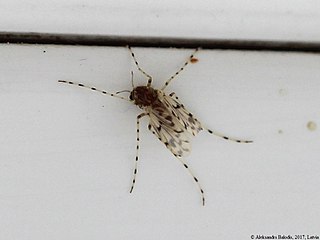Related Research Articles

The Chironomidae comprise a family of nematoceran flies with a global distribution. They are closely related to the Ceratopogonidae, Simuliidae, and Thaumaleidae. Many species superficially resemble mosquitoes, but they lack the wing scales and elongated mouthparts of the Culicidae.
Antillocladius is a genus of midges belonging to the family Chironomidae, subfamily Orthocladiinae. The name Antillocladius means orthoclad that occurs in the Antilles, where it was primarily recorded.
Litocladius is a genus of chironomid midges that belongs to the subfamily Orthocladiinae and is composed of three species, Litocladius confusus Mendes et Andersen (2008), Litocladius mateusi Mendes, Andersen & Sæther (2004), and Litocladius floripa Mendes et Andersen (2008) all described from Brazil only. Male, female, and pupa of the type species are described, the remaining two species are known only from the male adults. This species are known from the Atlantic Forest, along the Brazilian coastline.
Ichthyocladius is a genus of chironomid midges that belongs to the subfamily Orthocladiinae described by Fittkau based on one species, Ichthyocladius neotropicus, from Peru, though some other species were recognised, the lack of knowledge did not allow their description. Two additional species from Brazil were described by Mendes, Andersen & Sæther.

Limoniidae is the largest of four crane fly families, with more than 10,700 species in more than 150 genera. Some studies have suggested it to be a paraphyletic group, with some limoniids being more closely related to Tipulidae and Cylindrotomidae than to other limoniids. Limoniid crane flies can usually be distinguished by the way the wings are held at rest. Limoniids usually hold/fold the wings along the back of the body, whereas other crane flies usually hold them out at right angles. Snow flies such as Chionea scita have no wings at all. Limoniids are also usually smaller than other crane flies, with some exceptions.

Orthocladiinae is a subfamily of midges in the non-biting midge family (Chironomidae). For lack of a better common name, they are simply referred to as orthoclads.
Qiniella is a genus of non-biting midges in the diptera subfamily Orthocladiinae of the family Chironomidae.
Asheum is a genus of European non-biting midges in the subfamily Chironominae of the bloodworm family Chironomidae. It was originally named Pedionomus by James E. Sublette in 1964; this name was discovered by Patrick Ashe to be preoccupied by PedionomusGould, 1840, so it was renamed to Asheum by both James E. and Mary S. Sublette in 1983, naming it after Patrick Ashe. Asheum is sometimes considered to be a subgenus of Polypedilum.
Apometriocnemus is a genus of non-biting midges in the subfamily Chironominae of the bloodworm family Chironomidae.
Euryhapsis is a genus of European non-biting midges in the subfamily Orthocladiinae of the bloodworm family (Chironomidae).
Gymnometriocnemus is a genus of non-biting midges in the subfamily Orthocladiinae of the bloodworm family (Chironomidae). The genus is divided into two subgenera, Raphidocladius Sæther 1983 and Gymnometriocnemus Goetghebuer, 1932. Males of the former subgenus are characterized by possessing an extremely long virga with needle-like sclerotization, species of the later characterized by a short virga and a weakly developed crista dorsalis in the adult male hypopygium.

Metriocnemus is a genus of non-biting midges in the subfamily Orthocladiinae of the bloodworm family Chironomidae.
Beckidia is a genus of non-biting midges in the subfamily Chironominae of the bloodworm family Chironomidae.

Polypedilum is a genus of non-biting midges in the subfamily Chironominae of the bloodworm family Chironomidae. This is probably the most species-rich of all chironomid genera. Larvae of Polypedilum may also be among the most abundant invertebrates in eutrophic ponds, reaching densities of up to 1200 larvae per square meter.
Beardius is a genus of Pan-American non-biting midges in the subfamily Chironominae of the bloodworm family Chironomidae. It is named after the late Melvin Beard, a student at Eastern New Mexico University.

Tanypodinae is a subfamily of midges in the non-biting midge family (Chironomidae). The larvae are generally carnivorous and their mouthparts are adapted for predation on small invertebrates although 1st and 2nd instar larvae also feed on algae.
Zavrelimyia is a genus of non-biting midges in the subfamily Tanypodinae of the family Chironomidae.

Prodiamesinae is a subfamily of midges in the non-biting midge family (Chironomidae).
Protanypus is a genus of non-biting midges in the subfamily Diamesinae of the bloodworm family Chironomidae.

The Cylindrotomidae or long-bodied craneflies are a family of crane flies. More than 65 extant species in 9 genera occur worldwide. There are more than 20 extinct species.
References
- 1 2 Marziali, L.; Casalegno C.; Rossaro, B. (2004). "The first record of the subfamily Buchonomyiinae (Diptera, Chironomidae) from Italy" (PDF). Italian Journal of Zoology. Italy: Taylor & Francis. 71 (4): 341–346. doi:10.1080/11250000409356593. hdl: 2434/6420 . ISSN 1125-0003. S2CID 53373213 . Retrieved 2009-04-06.
- ↑ Ashe, Patrick; O'Connor, James P.; Murray, Declan A. (2015-07-02). "A review of the distribution and ecology of Buchonomyia thienemanni Fittkau (Diptera: Chironomidae) including a first record for Russia". European Journal of Environmental Sciences. 5 (1): 5–11. doi: 10.14712/23361964.2015.69 . ISSN 2336-1964.